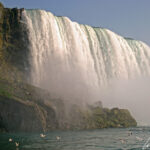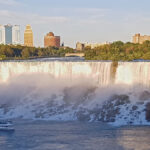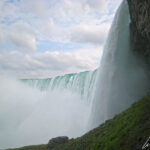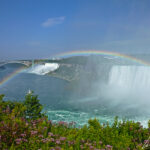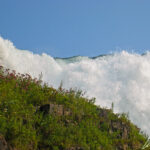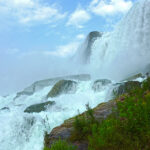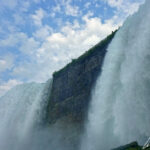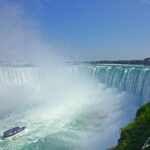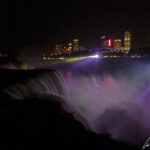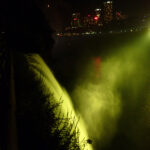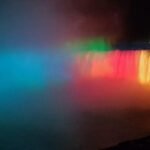Niagara Falls attract approximately 20 million visitors each year. They form a natural boundary between the province of Ontario in Canada and the State of New York in the Eastern United States and are located 17 miles northwest of Buffalo, New York, and 75 miles southeast of Toronto on either side of the Niagara River, which connects Lake Erie to Lake Ontario. The Falls were the setting for the American movie « Niagara », a 1953 film noir thriller (but in color) directed by Henry Hathaway. The movie stars Marilyn Monroe (one of the few films in which Marilyn plays a villain.) Although the Falls are a little wonder of Mother Nature, they are in an urban area and are both daytime and nighttime attractions. Everything is done to entertain tourists, especially on the Canadian side where the « Street of fun » and its well-known, kitschy attractions (haunted house, the maze of mirrors or wax museum.) The surroundings are more like Disney Land than the Canadian wilderness. Anyway, we don’t go to Niagara to discover the city but to see the majestic falls. Forget the idea of exploring Niagara Falls on a remote wilderness trail and take full advantage of the many observation points and activities offered day and night.

From the Canadian coast, we can admire 3 Niagara Falls. From left to right: Americans Falls, Bridal Veil Falls and Horseshoe Falls.
Niagara Falls: a refreshing trio of waterfalls
You are tired of still water ? You prefer streams that are not long, quiet rivers but rather ones where the water rumbles and roars and then turns into imposing waterfalls ? Then you will be seduced by Niagara Falls, a trio of waterfalls: Horseshoe Falls, American Falls, and Bridal Veil Falls. Established in 1885 as the Niagara Reservation, Niagara Falls State Park is the oldest state park in the United States. In this park, the American Falls, entirely in the United States, is nearly 950 feet wide. The height of the American Falls ranges between 70 and 110 feet, measured from the top of the falls to top of the rock pile. The rock pile, or talus, results from a landslide in 1954. The height from the top of the fall to the Niagara River is 188 feet. Bridal Veil Falls is the smallest of the three falls. It is also located in the United States and is separated from the American Falls by Luna Island. Bridal Veil Falls are 57 feet wide and 78 feet high from the top to the top of the talus and 181 feet to the Niagara River.

300 meters wide and 20 to 30 meters high. These are the incredible dimensions of the American Falls.
« Near Goat Island, the foam is white; it is like fresh snow or a stream of melted silver flowing into the abyss. In the center of the cataract, the color of the water is a most beautiful sea-green, which indicates its depth, so that the “Detroit,” a ship drawing twenty feet and launched on the current, was able to descend the falls without grazing ».
(Floating City by Jules Verne, 1869)
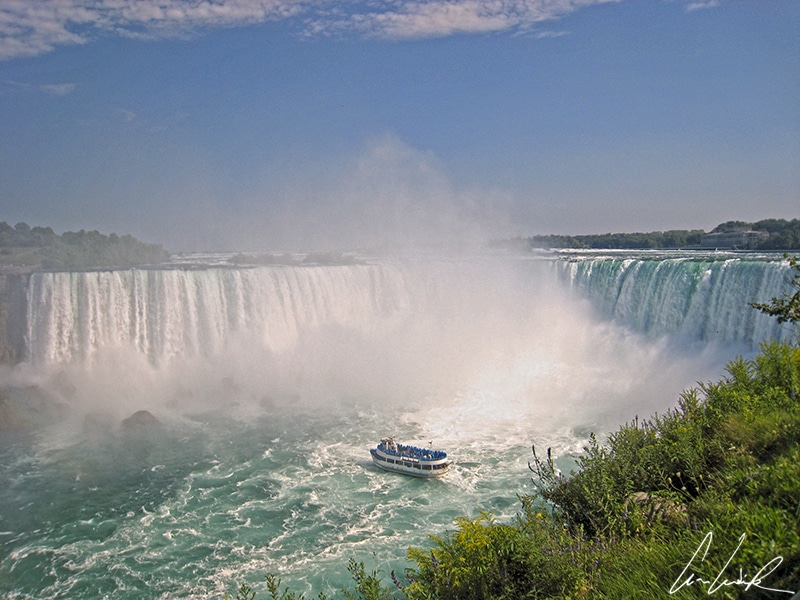
The boats of the Maid of the Mist stand next to the Horseshoe Falls, the most famous of the three Niagara Falls.
In addition to filmmakers, the Horseshoe Falls has also inspired a daredevil group called « The Barrel Brigade », which has made headlines for attacking the falls in makeshift boats or even simple barrels. In 1829, Sam Patch (nicknamed the Yankee Jumper) jumped into the Horseshoe and was the first to come out alive. In 1901, Annie Edson Taylor, a 63-year-old schoolteacher, decided to jump and conquer the falls in a barrel… and survived. In the race for the Darwin Awards, William Red Hill Jr. lost his life on August 5, 1951, while trying to jump from the falls despite equipment designed to protect him. In 2003, Kirk Jones was the first to survive the plunge without any protection, wearing only the clothes on his back. Could it be the evil power of the falls evoked in Joyce Carol Oates’ novel that drove this group of daredevils to attempt the great plunge ?
« For seven days and seven nights the Widow-Bride of the Falls was to be found at the Niagara Gorge, on Goat Island or onshore; she joined search teams looking for the “missing” man, and accompanied a Coast Guard search crew in their downriver patrol past Lewiston and Youngstown, to the mouth of the river at Lake Ontario ».
(Joyce Carol Oates – The Falls, 2004)
Some anecdotes about the Niagara Falls
Niagara Falls is ranked among the most remarkable Falls in the world along with Salto Angel (Venezuela), Iguaçu Falls (Brazil-Argentina,) and Victoria Falls (Zambia-Zimbabwe). Niagara Falls are certainly not the highest falls in the world (there are about 500 higher falls in the world,) but they impress by the amount of water. Their formation dates back to the end of the ice age about 10,000 years ago when they were created by the Wisconsin glacier. This enormous glacier traveled for miles, pushing everything in its path, carving valleys, creating the Great Lakes and forming the rivers we know today. This slow process continues today. The Niagara River’s annual freezing and thawing wears away the rocks below the surface and gradual erosion and periodic rock falls regularly move the falls further upstream. They are already over a mile from where they were first formed about 10,000 years ago between present-day Lewiston, New York, and Queenston, Ontario. Up though the 1950s, water erosion caused the falls to retreat up to 3 feet per year and changed their shape. Remediation work was carried out to preserve them, and the volume of water was reduced, reducing erosion to only a few tens of centimeters per year.
« In this, one of the most beautiful spots in the world, Nature has brought everything together to astonish the eye. The fall of the Niagara singularly favors the effects of light and shade; the sunbeams falling on the water, capriciously varying it color. Those who have seen this effect must admit that it is without parallel ».
(Floating City by Jules Verne, 1869)
Speaking of freezing and thawing, I am reminded of an amusing anecdote of an event that occurred shortly before midnight on March 29, 1848: Niagara Falls turned into a trickle of water! Some people rushed to the churches, fearing that it was a sign announcing the world’s end! But the phenomenon was entirely natural, though infrequent. About 17 miles away, visitors from Buffalo reported that an ice blockage caused the falls to stop for about 40 hours. The wind had blown blocks of ice so as to form a dam stopping the Niagara River. Locals and tourists enjoyed crossing from one shore to the other on foot or on horseback, something usually impossible. Numerous artifacts were also discovered at the bottom of the river, such as rifles, bayonets, and tomahawks, which were evidence of the Anglo-American War of 1812. But the phenomenon was short-lived: on March 31, the ice gave way, and Niagara Falls once again becamespectacular and impassable ! The stop of Niagara Falls was a recurring April fool’s joke in the newspapers, but this stop of the falls, which took place just before April 1, was once a reality.

The power and beauty of the American Falls can be felt when you stand at the base of the falls.
If you like stories, you’ll also love the Native American legend Lelawala concerning Niagara Falls. A beautiful maiden was engaged by her father to a man she did not love. Rather than marry a man she despised, Lelawala wanted to be with her true love He-No, the God of Thunder (the story doesn’t say if he had a hammer too!) who lurked in a cave beneath Horseshoe Falls. To find him, Lelawala paddled a canoe down the Niagara River towards the falls and was swept over the falls. Fortunately, He-Ho (who may have been coming home from work singing “Heigh-ho, Heigh-ho, we’re coming home from work”) was watching and caught Lelawala as she fell. Then, they lived happily together in their cave, sheltered by the falls… If you feel like getting your shirt wet and going on an adventure to try and track down this unlikely couple, try « Journey behind the Falls ». You’ll be just a few feet from the Horseshoe Falls, and you’ll even pass behind it thanks to two tunnels (Cataract Portal and The Great Falls Portal). Dressed in your rain jacket, you can proudly face gusts of wind, splashes, and icy air. If you forgot your rain jacket, don’t panic, ugly yellow raincoats are provided on-site.

The Journey behind the Falls attraction will take you just a few feet from the Horseshoe Falls.
Niagara Falls: the American or Canadian side ?
Whether you are in the United States or Canada you should cross the border, via the Rainbow Bridge (in the background on the picture of course) by car or even on foot. The best views are clearly from the caribou country side as there the falls are facing you! A short stroll along the Niagara Parkway offers a magnificent view of the American Falls and Bridal Veil Falls. Continuing south, you reach a beautiful viewpoint, « Elements of the Falls ». Here, the contrast is striking between the calm of the water upstream and the power of Horseshoe Falls, which suddenly pours out in a thunderous noise. While the rapids above the falls reach speeds of 40 km/h, the speed at the falls themselves is up to 109 km/h. By the way, why does the water of Niagara Falls have that beautiful emerald green color ? Ah, ah, you are afraid to make a mistake… You’ll have to take the plunge! This surprising green color of the water flowing over the Niagara Falls is the byproduct of the estimated 60 tons per minute of dissolved minerals and « rock flour », or ground rock, swept away by the Niagara River ! The dissolved salts and « rock flour » are mainly limestone, shale and sandstone.

At Element of the Falls, the contrast between the calm of the water upstream and the power of the Horseshoe Falls is impressive.
On the American side, the ambiance is quite different. The falls are surrounded by a large park, the Niagara Falls State Park, while the small town of Niagara Falls (without the slightest hustle and bustle) is pushed a little further away. The effort is commendable because for, when you look at the falls from the Canadian side, the view is not spoiled by urbanization. « Cave of the Wind » on Goat Island is an excellent viewpoint that takes you down to the Bridal Veil Falls. With a rain wrap (useless), you can take wooden footbridges to the Hurricane platform just a few feet away from Bridal Veil Falls. You’ll feel like you’re in the heart of the falls, surrounded by the roaring water of a tropical storm but safe in the calm ambiance of a heavy drizzle. In short, you’ll come out of it completely soaked. But the shower is worth it: the sound of tons of water falling from the Bridal Veil Falls and American Falls on to the rocks is an impressive sight.

Cave of the Wind, on the American side, allows you to find yourself in the heart of the Bridal Veil Falls.
Niagara Falls: boat tour and night-time illuminations
To complete the picture (don’t hesitate to admire Frederic Edwin Church’s 1857 painting Niagara Falls), play the freshwater sailor by taking a boat ride to get closer to the falls. During this short 20-minute cruise, you’ll be as happy as a fish in water, and you’ll need to dry off again when you disembark. You can board the « Maid of the Mist » (American side) or the « Hornblower Niagara Cruises »(Canadian side). To convince you, Marilyn Monroe also let the « Maid of the Mist » take her on board 70 years ago ! Near the Horseshoe Falls, the boats approach the curtain of water and fight the current: the roar of the water, the mist rising to the sky, the feeling of being in the middle of a storm. It’s just freaking magical !

At night, the Niagara Falls take on a colorful look thanks to projectors.
At night, the falls are there, omnipresent and deafening. You can hear them long before you see them. You stumble impatiently, you look for them, and what a surprise to discover them, adorned in their garments of light. In the evening, Niagara Falls takes on a completely different face, red, blue, yellow or even purple, illuminated by colorful spotlights. It would be a shame to miss these illuminations by leaving too early to visit the rest of the country like the eccentric character in Jules Verne’s novel:
« Niagara is too well known. I’ve already visited it twenty times. I’m worn out, I tell you. I’m worn out by the American waterfall, the Canadian waterfall, the Cave of the Winds, Goat Island. And it’s all too close to Chicago. What I want to see is the country. I want to be dragged all over the Union. I want to walk thousands of miles on my legs… »
(by Jules Verne – The Will of an Eccentric, 1899)
Find more on Eastern USA

